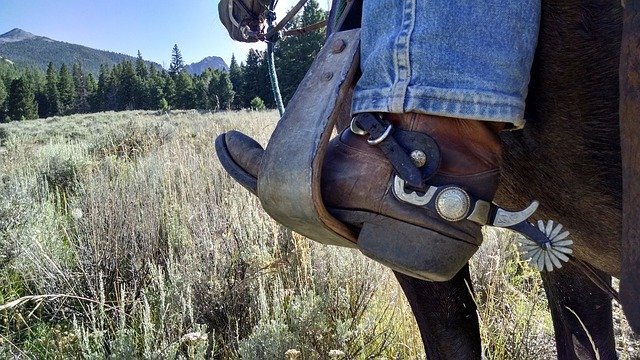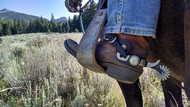Spurred or Spurned? Proper Spur Use for Happy Horseback Riding
May 4th 2021
 Proper spur use starts with determining if you need spurs, choosing the right spurs for your experience level and your horse, and training until you and your horse are comfortable with spurs.
Proper spur use starts with determining if you need spurs, choosing the right spurs for your experience level and your horse, and training until you and your horse are comfortable with spurs.
Some romanticize spurs as a throwback to the cowboy days of yore. Others find them a cruel means of urging a horse to get a move-on. For many horseback riders, however, they're simply a tool of the trade, providing an easy means of communicating with an animal.
That said, spurs can be tricky to use for the uninitiated. You can't just pop a pair on your boots and dig them into the side of the horse. Using spurs improperly could injure your animal, and in all likelihood, lead to rider injury, as well. How can you do it right?
Decide if You Need Spurs
First of all, let's just take a moment to consider whether you need spurs or not. Many riders are able to get their horses to do incredible things with nary a spur or riding crop for incentive. Just look at what professional dressage riders can do!
For horses that respond well to leg commands, you shouldn't need a spur, and in fact, it could complicate matters. For example, they could elicit a strong response when all you want is a gentle trot. If your horse has stopped responding to leg commands, however, a spur can help to reinforce commands and stimulate response.
Choose the Right Spurs
There are many different kinds of spurs. You'll find options that are short or long, pointy or rounded, and so on. If you're new to using spurs and you're worried about harming your horse, rounded spurs are preferable, and you'll find there are a variety of different beginner spurs that allow you and your horse to learn together.
How to Spur a Horse
When learning to use spurs, you need to start with good riding skills, including independent hands, seat, and legs. This frees you up to focus on spurring without major concern that you'll be thrown while learning something new.
You'll start the process by introducing your horse to the spurs from the ground (i.e., not seated). Let your horse see and hear the spurs so they don't spook him later on. Next, use the spurs in-hand to apply gentle pressure to the flank, where you'll likely use them while riding. Add pressure until the horse moves away, then remove the spur.
When you feel comfortable, try using spurs from a seated position, starting with gentle pressure timed with leg cues to let your horse know what you want. In time, you'll be able to cue your horse with minimal spurring, using it mainly to reinforce leg application.
In Conclusion
Once you've decided spurs are necessary for effective riding, make sure to choose the right spurs and learn how to properly use them to communicate with your animal.

